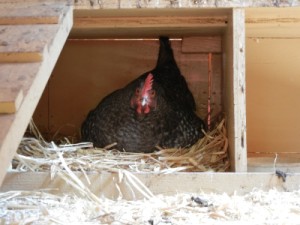This month’s Hen Herald is on chicken vocalization. While Denise thought she had heard it all from her hens and was going to report on what Henny, Penny, and Sky had to say during a usual day, she was pleasantly surprised to find out she had more to learn as Henny displays a new behavior.
Each of the hens makes some unique noises, along with common sounds that all chickens make. However, it should be noted that depending on breed, size or other factors, one chicken’s cluck does not sound like the next chicken’s cluck. Henny, Penny, and Sky are similar enough in size that the common chicken noises sound pretty much alike, either that or this reporter’s ears can’t pick up the difference. But Henny makes the most unique sounds and has recently added many sounds to her vocabulary.

Henny has decided that she does want to brood eggs and has been sitting on the nest for about two weeks now. Because she is broody, Henny is making noises she has not made before and the common noises that she used to make, are now much LOUDER. Denise daily takes the eggs from her and puts her outside for food and a bit of exercise. Turns out Henny has stopped laying eggs while brooding, and only broods Penny and Sky’s eggs. Poor Penny and Sky have to wiggle their way into the nest and lay an egg while Henny is still sitting.
Denise and Andrea have several chicken books (they wish to thank all that have given them as gifts), and believe it or not, none of these books mentions anything about the vocalizations of chickens. Not even a reference to the well known “cock-a-doodle-do.” Denise finds this very odd, since one of her favorite things is to listen to the sounds of her chickens – and chickens do a lot of talking. Visitors also comment on the interesting sounds that Henny, Penny, and Sky make as they go about their business. A little research on the internet quickly proves that many other chicken owners like to talk about the sounds their chickens make and there are several scientists studying the vocalization of chickens.
According to scientific work, chickens have about 24 different vocalizations (http://www.wardhenline.com/uncooped/communicative_abilities). Other researchers are using the sounds chickens make to learn what is stressful to them. For example, chickens that feel crowded make a particular sound, thus anyone who wants to raise chickens commercially and humanely can use this type of vocalization to listen for over-crowding (http://veterinarynews.dvm360.com/bird-vocalization-provides-insight-poultry-industry-veterinarians). As research continues, scientists may find that there are subtle differences in even the 24 known sounds, and that chickens may have their own language.
When chickens are very young (puff-ball stage) they mostly make a peeping sound. As they mature the peeping becomes more of a chirping with other vocalizations starting to emerge. As adults, and apparently at different stages of life (such as during brooding), the number of vocalizations greatly increases.
Denise sure believes her chickens make more than 24 types of sounds, and has come up with her own list of a few of the common sounds her hens make. Here are a few that she thought she could describe:
Sharp Clucking – can be quite chatty but quiet from a content hen, or if stressed, very loud.
Scratchy Clucking – these come in a variety of styles (say with a scratchiness “Cluck . . . .Cluck . . . . Cluck, etc.” or “Cluck, Cluck, Cluck, Clllluuuuuccckkkk,”). This sound usually comes from a hen who wants out of the pen.
HaHaHaHaHaHAAAAAAA – very rapid and loud, again from a hen who wants out. Sounds a lot like a laugh.
Growling – a new sound Henny makes while brooding, if disturbed, she also puffs up her feathers.
Purring – a sound Denise has only heard Sky make as she rests under shrubs.
Cooing/trilling – a sound made when wandering around looking for food or checking out the surroundings. A very soothing sound to human ears.
Baawk – a sound usual made when the hen is concerned about a situation. As in “I am all alone – where are you?” The vocalization is usually loud and rises in volume towards the end of the vocalization – Bawk, Bawk, Bawk Baaaawwwwwwkkkk.
ARRRRRR – another unique sound that Henny makes. Henny stretches and flaps her wings and let’s out a ARRRRRR, which has the characteristics of the last part of a rooster crow. Seems to be a message of “It’s great to be alive”.
Beep – only Henny makes this sound. After a quick shake of her head, a sharp beep sound emerges. Denise swears it looks like a sneeze.
Squawk – loud, sharp and long. A noise made when the hens are startled – such as when one hen, flying off a perch, lands on another hen’s back.
Whimper – Penny’s bad egg days. Every once in a while Penny has a bad egg day and does not feel good. She just stands, hunched up, eyes partly closed, tail drooping and whimpers. But we are happy to report; she has not had a bad day for a long time.
Andrea and Denise would like to mention that you don’t need a rooster and their crowing to get you up in the morning. All you need are a few hens who want to be fed and have decided to laugh right outside your bedroom window as the sun is coming up.
If you get a chance to hang with chickens I am sure you will agree that their vocalizations are very interesting and entertaining.